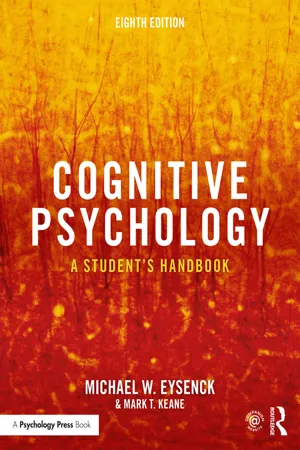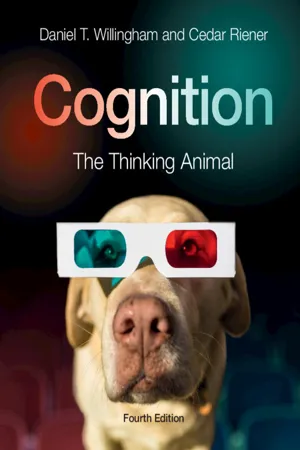Psychology
Cognitive approach
The cognitive approach in psychology focuses on understanding mental processes such as perception, memory, and problem-solving. It emphasizes how people process information, make decisions, and solve problems, and it explores the role of cognitive processes in shaping behavior and emotions. This approach has led to the development of cognitive therapies and interventions for various psychological disorders.
Written by Perlego with AI-assistance
Related key terms
1 of 5
10 Key excerpts on "Cognitive approach"
- eBook - PDF
Cognitive Psychology
A Student's Handbook
- Michael W. Eysenck, Mark T. Keane(Authors)
- 2020(Publication Date)
- Psychology Press(Publisher)
Approaches to human cognition INTRODUCTION We are now well into the third millennium and there is ever-increasing interest in unravelling the mysteries of the human brain and mind. This interest is reflected in the substantial upsurge of scientific research within cognitive psychology and cognitive neuroscience. In addition, the Cognitive approach has become increasingly influential within clinical psychology. In that area, it is recognised that cognitive processes (especially cognitive biases) play a major role in the development (and successful treatment) of mental disorders (see Chapter 15). In similar fashion, social psychologists increasingly focus on social cognition. This focuses on the role of cognitive processes in influencing individuals’ behaviour in social situations. For example, suppose other people respond with laughter when you tell them a joke. This laughter is often ambiguous – they may be laughing with you or at you (Walsh et al., 2015). Your subsequent behaviour is likely to be influenced by your cognitive interpretation of their laughter. What is cognitive psychology? It is concerned with the internal pro- cesses involved in making sense of the environment and deciding on appropriate action. These processes include attention, perception, learn- ing, memory, language, problem solving, reasoning and thinking. We can define cognitive psychology as aiming to understand human cognition by observing the behaviour of people performing various cognitive tasks. However, the term “cognitive psychology” can also be used more broadly to include brain activity and structure as relevant information for under- standing human cognition. It is in this broader sense that it is used in the title of this book. Here is a simple example of cognitive psychology in action. Frederick (2005) developed a test (the Cognitive Reflection Test) that included the following item: A bat and a ball cost $1.10 in total. - eBook - PDF
- Margaret W. Matlin(Author)
- 2014(Publication Date)
- Wiley(Publisher)
A related term, cognitive psychology, has two meanings: (1) Sometimes it is a synonym for the word cognition, and so it refers to the variety of mental activities we just listed. (2) Sometimes it refers to a particular theoretical approach to psychology. Introducing Cognitive Psychology 3 Specifically, the Cognitive approach is a theoretical orientation that emphasizes people’s thought processes and their knowledge. For example, a cognitive explanation of ethnic stereotypes would emphasize topics such as the influence of these stereotypes on the judgments we make about people from different ethnic groups (Whitley & Kite, 2010). Psychologists often contrast the Cognitive approach with several other current the- oretical approaches. For example, the behaviorist approach emphasizes our observable behaviors, and the psychodynamic approach focuses on our unconscious emotions. To explain ethnic stereotypes, these two approaches would describe our behaviors or our emotions, rather than our thought processes. Why should you and other students learn about cognition? One reason is that cognition occupies a major portion of human psychology. In fact, almost everything you have done in the past hour required you to perceive, remember, use language, or think. As you’ll soon see, psychologists have discovered some impressive information about every topic in cognitive psychology. Even though cognitive psychology is extraordinarily central in every human’s daily life, many college students cannot define this term accurately (Maynard, 2006; Maynard et al., 2004). To demonstrate this point, try Demonstration 1.1. A second reason to study cognition is that the Cognitive approach has widespread influence on other areas of psychology, such as clinical psychology, educational psychology, and social psychology. Let’s consider an example from clinical psychology. One cognitive task asks people to recall a specific memory from their past. - Dominic Upton(Author)
- 2013(Publication Date)
- Routledge(Publisher)
cognitive revolution ’, and grew in part out of increasing dissatisfaction with behaviourist explanations. Cognitive psychology is concerned with human thought processes and the ways in which these processes interact with behaviour (Eysenck and Keane, 2010). There are many facets of cognitive psychology but some of the major areas include memory, learning, intelligence, thinking and language. Like behaviourism it too rejects introspection as a valid method of investigation and maintains that the only true source of knowledge is that which is obtained through observation and experiment (Eysenck and Keane, 2010). Yet somewhat incongruous to this is the fact that it explicitly acknowledges the existence of unobservable mental processes. Although there have been many contributors to cognitive psychology, no specific person can be identified as central to its development. What is more, unlike other approaches cognitive psychology does not yet have a unifying theory.Information processingAssumptions of the Cognitive approachAcknowledges the existence of unobservable mental processes and emphasises their importance in determining and predicting behaviour. Accepts empiricist ideas and use of the scientific method. Is based mainly on laboratory experiments. Views the mind as an information processor, i.e. it computes answers to problems in a manner analogous to a computer. Psychologists have often tried to understand human cognition by comparing it with something less abstract and better understood. Hence the advent of the modern digital computer provided psychologists with an ideal metaphor for conceptualising how the mind worked and inspired what is now the main paradigm within cognitive psychology: the information processing approach (e.g. Forgas and Jennifer, 2001). According to this approach, the mind is analogous to an information processing system: inputting, storing and retrieving data. This system is used in flexible ways to handle all kinds of cognitive tasks, from reading the newspaper to playing a game of chess. An early version of the information processing approach is shown in Figure 2.4- eBook - PDF
- Thomas A. Farmer, Margaret W. Matlin(Authors)
- 2023(Publication Date)
- Wiley(Publisher)
3. According to the information-processing approach, mental pro- cesses operate like a computer, with information flowing through a series of processing systems and subsystems. 4. Enthusiasm for the classic information-processing approach has declined because cognitive psychologists now realize that human thinking requires more complex models. 5. According to the connectionist approach, cognitive processes can be represented in terms of networks of neurons; furthermore, many operations can proceed at the same time, in parallel, rather than one step at a time. 6. The area of cognitive neuroscience combines the research tech- niques of cognitive psychology with a variety of methods for assessing the brain’s structure and function. C H A P T E R R E V I E W Q U E S T I O N S 1. Define the terms cognition and cognitive psychology. Now think about your ideal career, and suggest several ways in which the information from cognitive psychology would be relevant to this career. 2. Compare the following approaches to psychology, with respect to their specific emphasis on human thinking: (a) William James’s approach, (b) behaviorism, (c) Tolman’s contribution, (d) gestalt psychology, and (e) the Cognitive approach. 3. This chapter addresses the trade-off between ecological validity and carefully controlled research. Define these two concepts. Then compare the following approaches in terms of their emphasis on each concept: (a) Ebbinghaus’s approach to memory, (b) James’s approach to psychological processes, (c) the behaviorist approach, (d) the cognitive psychology approach from several decades ago, and (e) current cognitive psychology research. 4. List several reasons for the increased interest in cognitive psy- chology and the decline of the behaviorist approach. In addition, describe the field of cognitive science, noting the disciplines that are included in this field. - Lorelle J. Burton, Drew Westen, Robin M. Kowalski(Authors)
- 2022(Publication Date)
- Wiley(Publisher)
Pdf_Folio:19 CHAPTER 1 Psychology: the study of mental processes and behaviour 19 The cognitive perspective is useful not only in examining memory but also in understanding processes such as decision making. When people enter a car showroom, they have a set of attributes in their minds: for example, smooth ride, sleek look, good fuel economy, affordable price. They must also process a great deal of new information (the car dealer’s description of one model as a ‘real steal’, for instance) and match it with stored linguistic knowledge. This allows them to comprehend the meaning of the dealer’s speech, such as the connotation of ‘real steal’ (from both his viewpoint and theirs). In deciding which car to buy, they must somehow integrate information about multiple attributes and weigh their importance. As we will see, some of these processes are conscious or explicit, whereas others happen through the silent whirring of our neural ‘engines’. APPLY AND DISCUSS A four-year-old is about to grab a lolly off the shelf at a shop, and his older sister says, ‘No, don’t take that. That would be stealing’. • How would a psychologist from a behaviourist perspec- tive explain both children’s behaviour? How did their learning history shape their actions? • How would a psychologist from a cognitive perspective explain their behaviour? What made the four-year-old think that inside this lolly wrapper would be something tasty? How did the older child learn to resist such temptations and to view stealing as wrong? Origins of the cognitive perspective The philosophical roots of the cognitive perspective lie in a series of questions about where knowledge comes from that the ancient Greek philosophers first raised and that British and European philosophers pondered during the last four centuries (see Gardner, 1985).- eBook - PDF
- Thomas A. Farmer, Margaret W. Matlin(Authors)
- 2019(Publication Date)
- Wiley(Publisher)
You also consulted your memory and your knowledge about language to search for word meanings and to link together the ideas in this paragraph. Addition- ally, right now, as you think about these cognitive tasks, you are engaging in another cognitive task called metacognition—you were thinking about your own thought processes. Perhaps you made an inference such as, “This book may help me learn to study more effectively.” You may have also used decision making by saying to yourself, for instance, “I’ll finish this section of the book before I eat lunch.” If cognition operates every time you acquire some information, place it in storage, transform that infor- mation, and use it…then cognition includes a wide range of mental processes! This textbook will explore many of these mental processes, such as perception, memory, imagery, language, problem solving, reason- ing, and decision making. Cognitive psychology has two meanings: (1) Sometimes it is a synonym for the word cognition; (2) Sometimes it refers to a particular theoretical approach to psychology. Specifically, the Cognitive approach is a theoretical orientation that emphasizes people’s thought processes and their knowledge. For example, a cognitive explanation of ethnic stereotypes would emphasize topics such as the influence of these stereotypes on the judgments we make about people from different ethnic groups (Whitley & Kite, 2010). I took Introduction to Cognitive Psychology during my junior year of college. I remember quite vividly that I had enrolled for the course because it was required, but I honestly had no idea what the term “cogni- tive psychology” meant. Even after our brief discussion of a definition of cognition, some of you may still not have a strong sense of what a cognitive psychologist really studies. Below, I offer a brief demonstra- tion that should help you gain a stronger sense of what you’re in store for over the course of the semester. - eBook - PDF
Child Psychology
Development in a Changing Society
- Robin Harwood, Scott A. Miller, Ross Vasta(Authors)
- 2012(Publication Date)
- Wiley(Publisher)
Learning Objective 8.1 Define the information processing approach and describe three methods of studying information processing. The Information Processing Approach to Cognition 283 previously stored in memory. Still others require determining an appropriate sequence of steps to arrive at a solution. The goal of the information processing approach is to specify these underlying psychological processes—and the developmental changes they undergo. Information processing approaches are based on a computer metaphor. Psychologists have observed that computers could systematically transform a variety of inputs into a va- riety of outputs. To do so, computers require precise programs that specify each step of the transformation. Information processing theorists saw in the digital computer a useful metaphor for the human mind. If scientists could specify the steps by which the mind transforms sensory inputs into cognitive or behavioral outputs, they would have a com- plete account of human thought. Methods of studying information processing include computer simulations, neural networks, and microgenetic studies. Computer Simulations and Neural Networks For many information processing theorists, the computer is not just a metaphor. It also provides a method—the computer simulation. In a computer simulation, the researcher attempts to program a computer in order to produce some aspect of intelligent behavior in the same way that humans produce the behavior. The idea is to build into the computer program whatever knowledge and computational abilities may be important for the human problem solver. Suppose, for example, that you want to test a theory of how first graders solve simple addition problems. You might program the computer to apply the rules that you think chil- dren use and then see how the computer responds to the same tasks. - eBook - PDF
Cognition
The Thinking Animal
- Daniel T. Willingham, Cedar Riener(Authors)
- 2019(Publication Date)
- Cambridge University Press(Publisher)
1 Cognitive Psychologists’ Approach to Research Introduction Why Make Assumptions? How Did Philosophers and Early Psychologists Study the Mind? • Philosophical underpinnings • The beginnings of modern psychology • The response: behaviorism • Behaviorism’ s success How Do Cognitive Psychologists Study the Mind? • What behaviorism couldn’t do • Failures of behaviorism to account for human behavior • The computer metaphor and information processing • The behaviorist response • Abstract constructs in other fields • So what, finally, is the cognitive perspective? Introduction When you are driving and your mind wanders from the song on the radio, to the next left turn you have to make, to what’ s for dinner, do you pause in the middle to wonder what makes your mind wander? Probably not. Most of the people we know do contemplate how the mind works, but only when their mind lets them down. They contemplate memory (“Why can’ t I remember the answer to this test question?”), attention (“I want to understand this material, so why can’ t I keep my focus on my book and not on my phone?”), and vision (“How could someone think those two colors go well together?”). Questions such as “How does vision work?” seem somewhat interesting, but no more interesting than thousands of other questions about how the world works (how do viruses work? How do cell phones work? How do your lungs work?). These questions become interesting to most people when they consider how the answers might help their own lives. For example, if we understood how vision worked, maybe we could build cars that can see (see Figure 1.1). To scientists, these questions are the fascinating entry into a world of other questions. Once we start looking a little closer and more systematically (by using the methods of science) we can uncover answers to these vital questions, but we also discover new layers of questions. - eBook - PDF
- Roxana Moreno(Author)
- 2011(Publication Date)
- Wiley(Publisher)
However, no single event can be claimed to have started the cognitive era. It was the combined work of several influential psychologists since the late 1950s that launched the development of Cognitive approaches to learning (Ausubel, 1960; Bruner, Goodnow, & Austin, 1956; Chomsky, 1957; Miller, 1956). Definition of Learning Cognitive views of learning are characterized by their focus on the changes in thought that are involved in learning. They emphasize the mental processes underlying the processing of new information, such as paying attention to an explanation, interpret- ing a graph, or relating new concepts to prior knowledge. Due to this emphasis, cog- nitive theory defines learning as a relatively enduring change in mental structures that occurs as a result of the interaction of an individual with the environment. Unlike behaviorists, cognitive psychologists argue that learning takes place in the mind; therefore, behavior is of interest not in itself but rather as a way to infer whether and how students’ mental structures have changed. Although changing the way that stu- dents think may result in behavioral change, this is not necessary according to cognitive views of learning. Imagine that a student in your class does not know what a mammal is. He does have experience with mammals (e.g., humans, dogs, cats) but he lacks this con- cept in his mental structures and, consequently, is unable to distinguish between mam- mals and other animals. Now imagine that you teach him about the characteristics of mammals. Although the student’s mental structures change after your lesson, his behav- ior may not change until he is called on to use this new information in a certain task, such as classifying a list of animals based on the definition of mammal that he just learned. - eBook - PDF
Child Psychology
A Canadian Perspective
- Alastair Younger, Scott A. Adler, Ross Vasta(Authors)
- 2014(Publication Date)
- Wiley(Publisher)
The chapter concludes with the challenging issue of cognitive change. THE NATURE OF THE INFORMATION-PROCESSING APPROACH As many commentators have noted, information processing is not a single theory, but rather a general framework within which researchers have developed a number of specific theories (Kail & Miller, 2006; Klahr & MacWhinney, 1998; Siegler, 2005). The common core that unites the different theories is the shared assumption implied by the name of the approach: thinking is information processing (Siegler & Alibali, 2005). The information to be processed can take many forms across different contexts and developmental levels; it might, for example, be a hard-to-work toy, a spatial landmark, a numerical symbol, or an instruction from the teach- er. The processing can also take many forms, depending on the demands of the task: attention to critical features, insertion into a conceptual category, and comparison with past memory input. Beyond basic cognitive develop- ment, the information-processing approach has also become the framework for understanding a whole range of developmental domains such as intelligence, emotional processing and behaviour in children, and adolescent antisocial behaviour. The goal of the information-processing approach, therefore, is to specify such underlying psychological processes—and the developmental changes they undergo. Two metaphors are instructive in characterizing the information-processing approach. One is the flowchart; the other is the computer. THE FLOWCHART METAPHOR Figure 9.1 shows the symbolic representation of a typical information-processing theory. This par- ticular theory, which deals with memory, contains a number of details that do not concern us here. However, its general features are characteristic of the information-processing approach. The starting point is some environmental input, and the end point is some response output.
Index pages curate the most relevant extracts from our library of academic textbooks. They’ve been created using an in-house natural language model (NLM), each adding context and meaning to key research topics.









